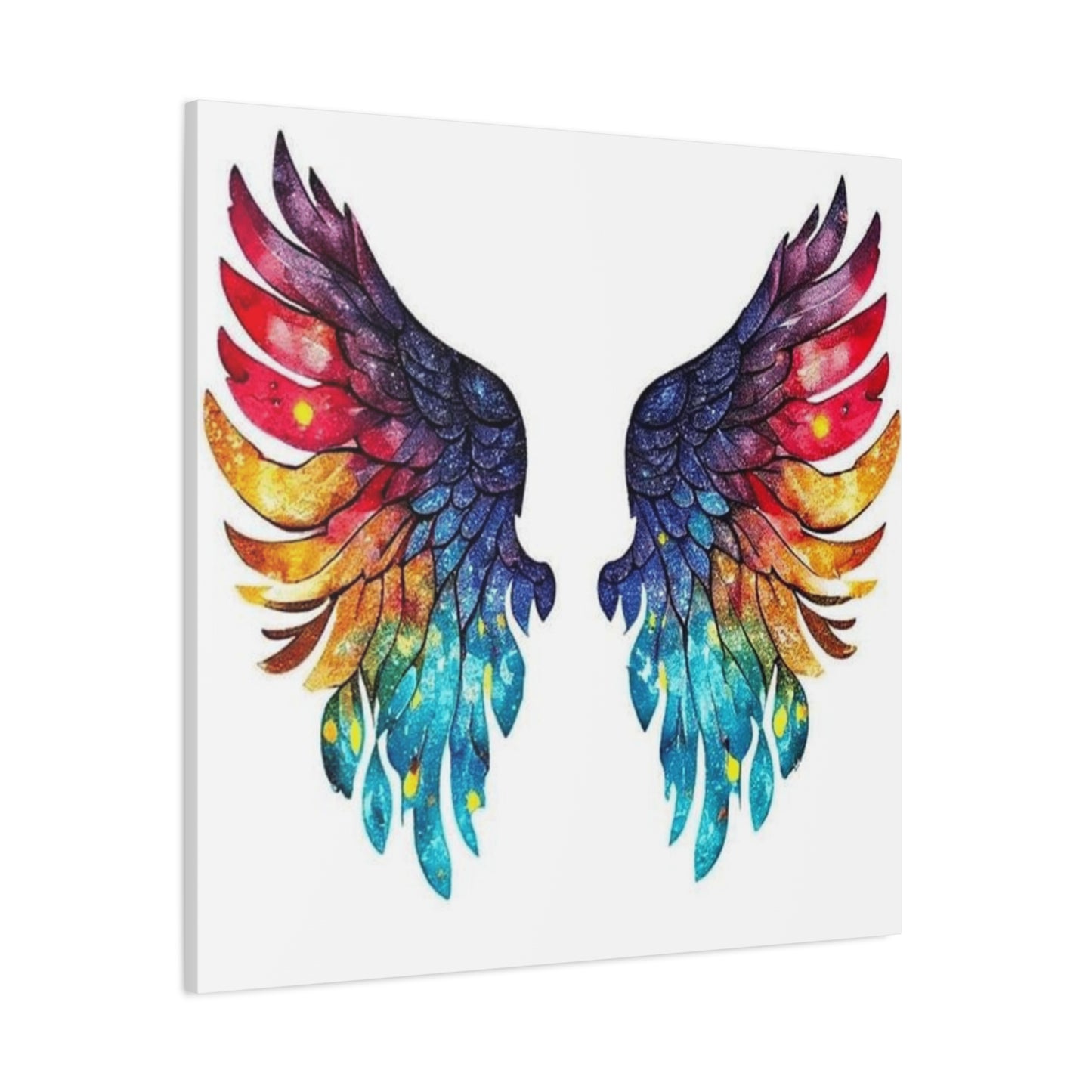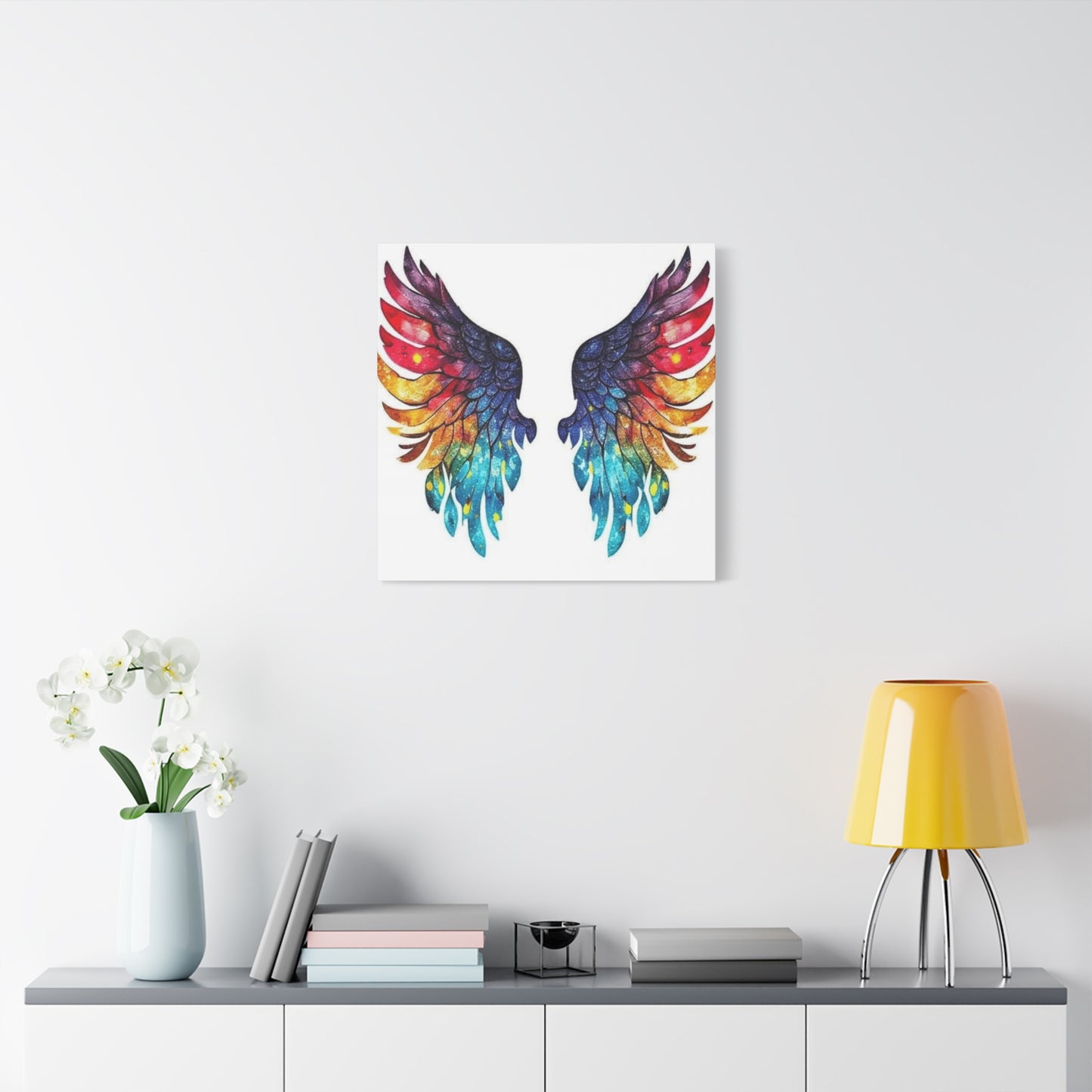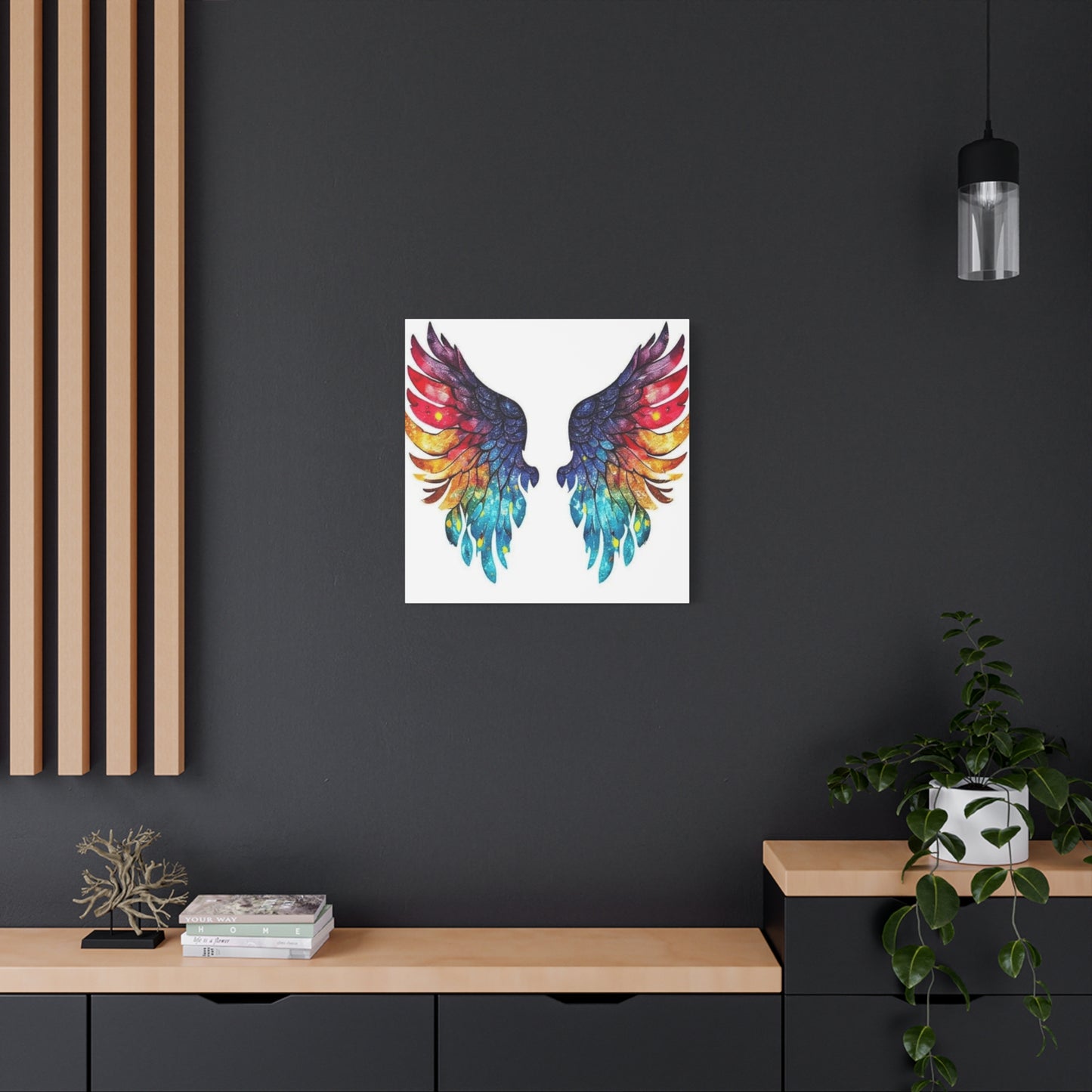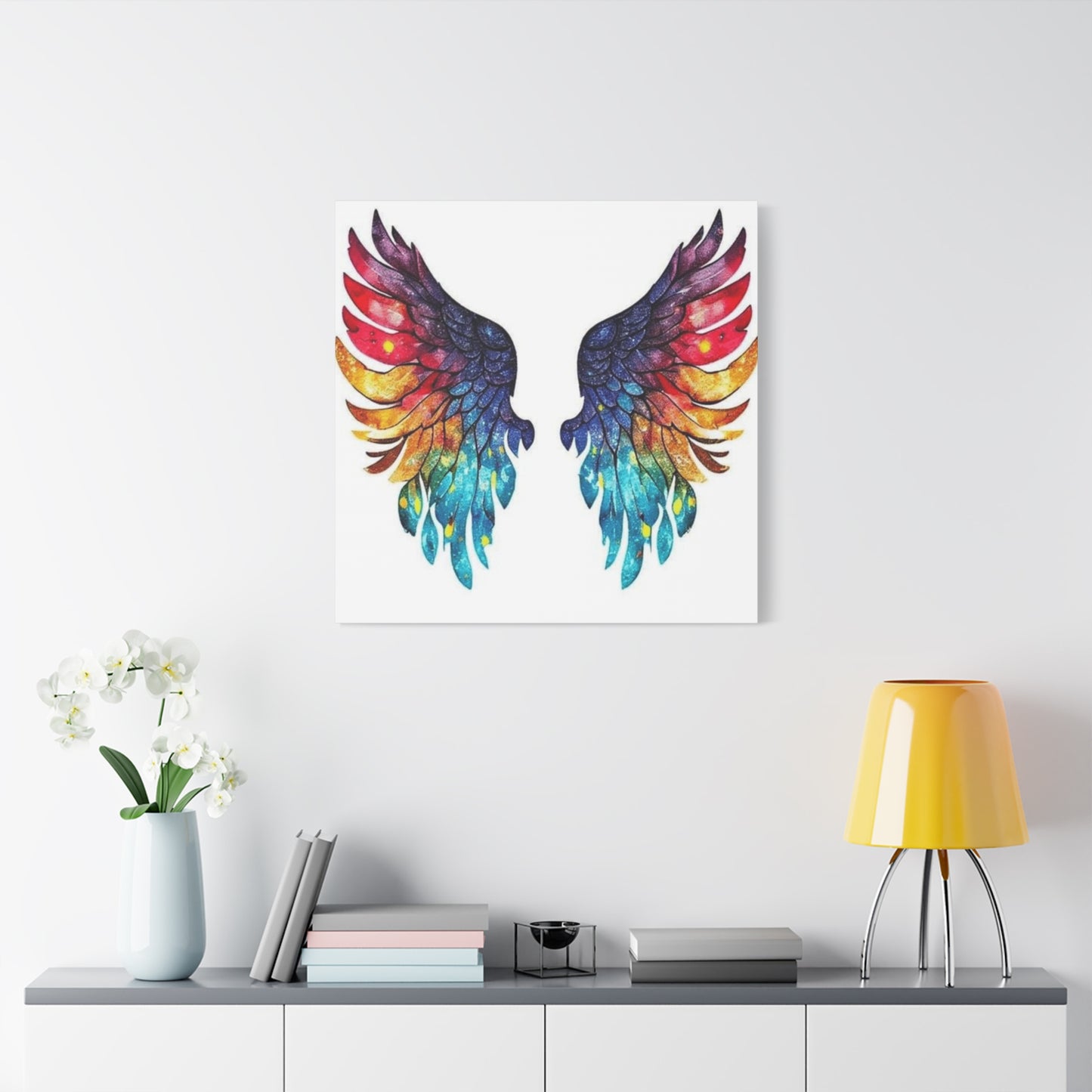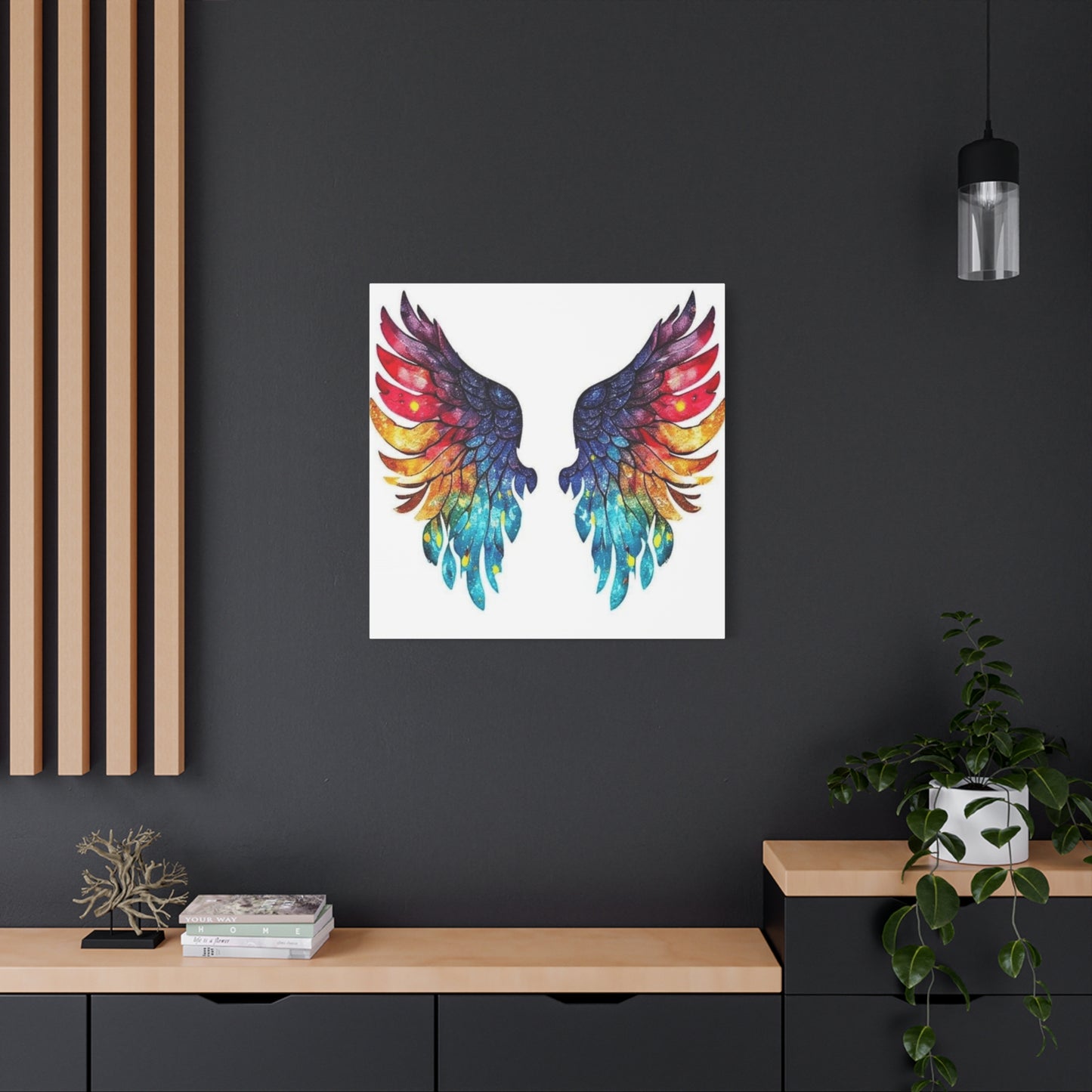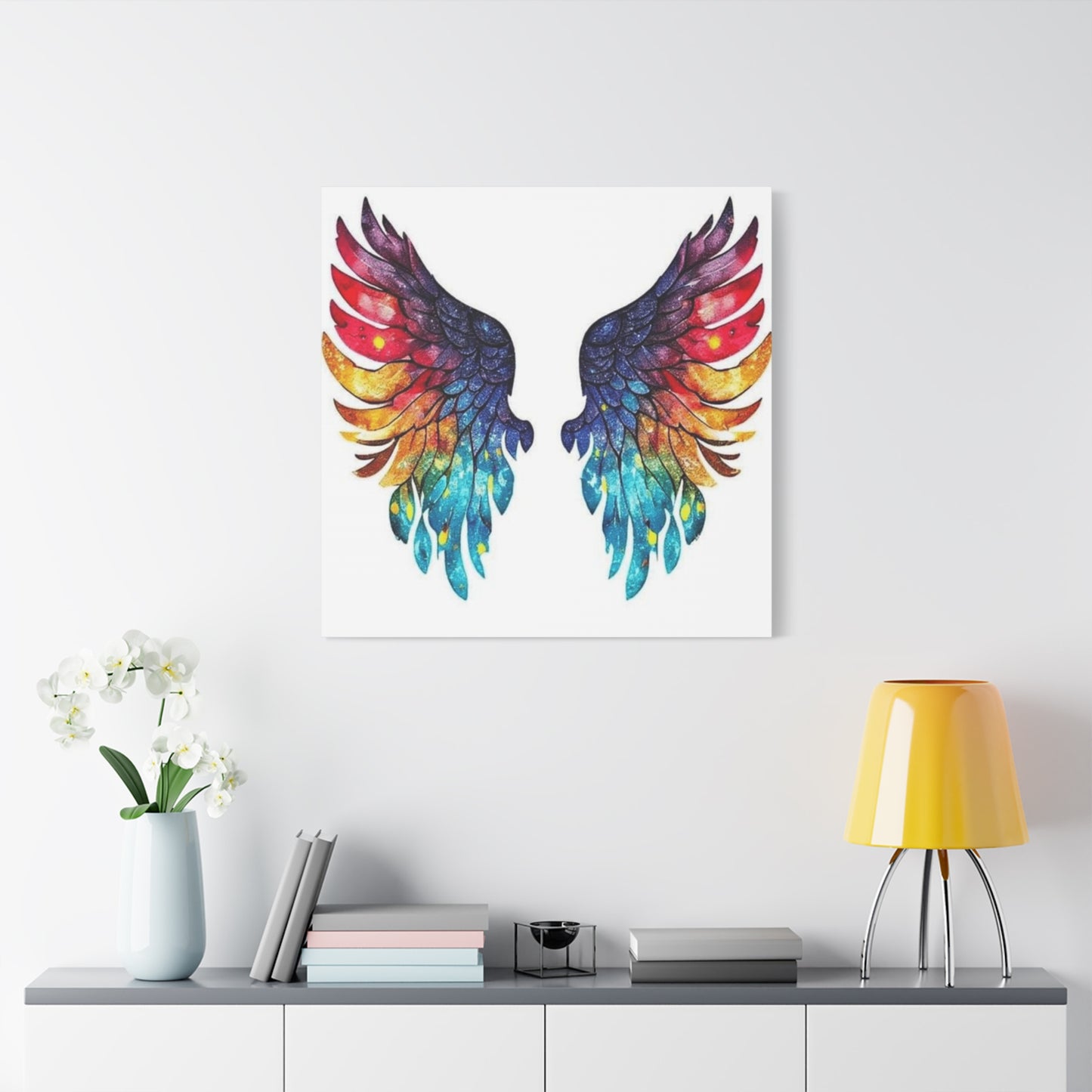Angel Wings Wall Art & Canvas Prints
Angel Wings Wall Art & Canvas Prints
Couldn't load pickup availability
Embrace the Tranquil Charm of Angel Wings Wall Art for a Sacred, Spiritual Ambience
The celestial charm of ethereal winged decorations has captivated homeowners, interior designers, and spiritual enthusiasts for generations. These magnificent pieces serve as powerful visual statements that transcend ordinary home embellishment, offering both aesthetic magnificence and profound symbolic resonance. When incorporated thoughtfully into living environments, these heavenly-inspired ornamentations create atmospheres of tranquility, protection, and divine connection that resonate deeply within the soul.
Throughout human civilization, wings have represented transcendence, freedom, and the connection between earthly existence and higher realms. These symbolic representations carry weight across numerous cultural traditions, spiritual practices, and artistic movements. The imagery of celestial wings specifically evokes notions of guardianship, divine intervention, and spiritual awakening that speak to fundamental human longings for protection and meaning.
In contemporary design contexts, these powerful symbols maintain their significance while adapting to modern aesthetic sensibilities. The visual impact of outstretched wings commands attention and creates focal points that anchor entire room compositions. Whether rendered in minimalist metalwork, ornate golden finishes, or rustic distressed materials, these pieces communicate messages of hope, transformation, and ethereal beauty that resonate across diverse belief systems and personal philosophies.
The psychological impact of displaying such meaningful imagery cannot be understated. Residents and visitors alike experience subtle shifts in emotional states when surrounded by symbols that evoke protection and transcendence. These decorative elements function as daily reminders of aspirations toward higher consciousness, moral elevation, and spiritual refinement. The presence of wing motifs creates visual anchors for meditation, contemplation, and moments of peaceful reflection within otherwise busy domestic environments.
Exploring Diverse Material Compositions and Craftsmanship Approaches
The realm of celestial wing decorations encompasses extraordinary variety in material selections and construction methods. Metal fabrications represent perhaps the most prevalent category, with options ranging from lightweight aluminum constructions to substantial wrought iron creations. These metallic pieces often feature intricate scrollwork, feather-like details, and dimensional layering that creates shadow depth and visual complexity.
Wooden interpretations offer warmth and organic texture that metal cannot replicate. Carved hardwood versions display exceptional craftsmanship through detailed feather delineation and sculptural dimensionality. Reclaimed wood pieces bring rustic character and environmental consciousness to these spiritual symbols, with weathered patinas telling stories of previous existence while embodying themes of renewal and transformation.
Resin castings provide affordable accessibility to elaborate designs that would be prohibitively expensive in other materials. Modern manufacturing processes enable incredibly detailed reproductions of complex feather structures and wing anatomies. These lightweight alternatives facilitate installation in spaces where weight considerations limit options, while finishing techniques can simulate metallic sheens, stone textures, or painted effects.
Canvas and fabric interpretations translate wing imagery into softer, more textural formats. These approaches often incorporate mixed media elements, combining printed imagery with three-dimensional embellishments, beadwork, or embroidery. The textile dimension introduces tactile qualities and movement possibilities that rigid materials cannot achieve, creating living artworks that respond to ambient air currents and lighting shifts.
Glass and crystal manifestations elevate wing imagery into luminous territories. Stained glass compositions capture and fragment light into spectacular chromatic displays, while crystal-embellished pieces sparkle with prismatic brilliance. These transparent and translucent interpretations emphasize the immaterial, ethereal nature of their subject matter, creating connections between physical objects and intangible spiritual concepts.
Sizing Considerations for Various Spatial Contexts
The scale of celestial wing decorations dramatically influences their visual impact and spatial appropriateness. Monumental installations spanning six to eight feet create breathtaking focal points in spaces with generous ceiling heights and expansive wall surfaces. These commanding pieces anchor entire rooms, often positioned above beds, behind sofas, or on prominent feature walls where their majesty can be fully appreciated.
Medium-scale pieces measuring three to five feet offer versatility for standard residential environments. These dimensions provide substantial presence without overwhelming modest room proportions. Paired installations flanking doorways, windows, or architectural features create balanced compositions that frame and enhance existing structural elements. The symmetry of matching wings generates visual harmony while doubling symbolic impact.
Smaller interpretations ranging from one to two feet serve specific decorative purposes in intimate spaces or grouped arrangements. Multiple petite wing pieces can be clustered to create gallery-style displays with varied heights, orientations, and material combinations. These diminutive versions excel in personal spaces like reading nooks, prayer corners, or bedside arrangements where close viewing distances reveal intricate details.
Proportional relationships between wing decorations and surrounding furnishings require thoughtful consideration. Oversized pieces above delicate furniture create jarring contrasts, while undersized decorations above substantial architectural elements appear insignificant. The width of wing spans should relate harmoniously to the dimensions of supporting walls and adjacent furniture pieces, typically occupying between one-half and two-thirds of the available horizontal space for optimal visual balance.
Color Palette Selections and Finish Variations
The chromatic treatment of celestial wing decorations profoundly affects their mood contribution and stylistic compatibility. Pure white finishes evoke angelic purity, creating serene atmospheres conducive to contemplation and spiritual practice. These pristine surfaces reflect light beautifully, brightening spaces while maintaining the ethereal quality central to their symbolic meaning. White works universally across color schemes, providing neutral elegance that complements rather than competes with surrounding palettes.
Metallic finishes transform wing imagery into luxurious statements. Gold treatments communicate opulence and divine radiance, referencing religious iconography across traditions. Silver and pewter tones offer sophisticated restraint with reflective qualities that animate surfaces with ambient light shifts. Bronze and copper patinas introduce warmth and antique character, suggesting artifacts from historical periods when spiritual symbolism pervaded daily existence.
Natural wood tones ground wing imagery in organic earthiness. Light woods like pine and birch maintain airy lightness, while darker species such as walnut and mahogany provide dramatic contrast and gravitas. Distressed and weathered finishes add vintage charm, suggesting sacred objects with histories of devotion and contemplation. The grain patterns and natural variations within wood materials ensure each piece possesses unique character.
Black finishes create striking contemporary statements, particularly effective in modern minimalist interiors. The stark contrast of dark wings against light walls generates powerful visual drama. This unconventional approach divorces wing imagery from traditional religious associations, allowing secular appreciation of the form's inherent sculptural beauty and symbolic power related to freedom and aspiration.
Multi-toned approaches combine several colors within single pieces, often employing gradient transitions or contrasting feather tips. These complex treatments add visual richness and prevent monotony in large-scale installations. Distressed multi-color finishes suggest age and spiritual authenticity, while clean color-blocked combinations align with contemporary design sensibilities.
Strategic Placement Strategies Throughout Residential Spaces
The bedroom represents the most popular location for celestial wing decorations, particularly positioned above headboards. This placement creates protective symbolism over sleeping occupants while establishing strong focal points in rooms often lacking architectural drama. The wings frame the head of the bed, drawing the eye upward and emphasizing verticality in spaces often dominated by horizontal lines.
Living rooms benefit from wing installations on primary feature walls, often above sofas or entertainment centers. These prominent positions ensure maximum visibility and impact, making powerful first impressions on visitors. The symbolic protection implied by wing imagery creates welcoming energy while sophisticated aesthetic execution demonstrates refined design sensibility.
Entryway and foyer placements leverage wing symbolism to create welcoming thresholds. Positioned near front doors, these decorations suggest protective guardianship over household boundaries, offering reassurance to residents and extending hospitality to guests. The transitional nature of entrance spaces aligns perfectly with wing imagery's themes of passage, transformation, and movement between realms.
Dining areas gain contemplative atmosphere through wing installations, particularly when positioned on walls visible from seating areas. The presence of spiritual symbols during shared meals elevates ordinary dining into more ceremonial experiences, encouraging gratitude and mindfulness around nourishment and family connection.
Home offices and creative studios utilize wing imagery to inspire elevated thinking and imaginative flights. The symbolic association with ascension and transcendence supports mental work requiring vision and innovative problem-solving. Wings positioned within sight lines from work surfaces provide visual breaks and contemplative focal points during periods of intense concentration.
Bathroom spaces, often overlooked for meaningful decoration, transform into private sanctuaries through wing installations. These intimate environments become personal retreats where spiritual symbols support self-care rituals and moments of solitary reflection. The juxtaposition of ethereal imagery with practical cleansing spaces creates interesting symbolic resonance.
Stairwells and hallways, sometimes dismissed as mere transitional spaces, gain significance through wing placements that emphasize their connective functions. These passages literally move occupants between different areas and levels, paralleling the symbolic transition between earthly and spiritual realms that wings represent.
Harmonizing With Diverse Interior Design Styles
The remarkable adaptability of wing imagery allows successful incorporation across vastly different aesthetic frameworks. Shabby chic and cottage styles embrace distressed white or pastel wing pieces that complement vintage furnishings and soft, romantic color palettes. The weathered textures and gentle colors align perfectly with this style's emphasis on comfortable, lived-in charm and nostalgic sentimentality.
Farmhouse and rustic aesthetics pair naturally with wooden wing interpretations, particularly those featuring reclaimed materials and visible grain patterns. The organic materials and handcrafted quality resonate with farmhouse values of authenticity, simplicity, and connection to agrarian traditions. These pieces integrate seamlessly with shiplap walls, exposed beams, and other architectural elements characteristic of rural-inspired interiors.
Contemporary and modern spaces accommodate wing imagery through sleek metallic finishes and geometric feather interpretations. Minimalist compositions emphasizing clean lines and sculptural form rather than ornate detail align with modern design principles. Monochromatic treatments in black, white, or polished metals maintain the restrained sophistication essential to contemporary aesthetics.
Industrial interiors incorporate wing elements through raw metal fabrications with visible welds, rivets, and deliberately unfinished appearances. The juxtaposition of ethereal symbolism with rough, utilitarian materials creates compelling contrasts. Oversized metal wings against exposed brick or concrete walls generate dramatic visual tension between delicate imagery and harsh architectural elements.
Bohemian spaces celebrate wing decorations featuring mixed materials, vibrant colors, and eclectic combinations. Fabric wings with beading and embroidery, pieces incorporating feathers and natural elements, or brightly painted wooden versions align with boho's free-spirited, globally-influenced aesthetic. These interpretations emphasize artistic expression and personal meaning over stylistic purity.
Traditional and classical interiors accommodate ornate wing pieces with gold leaf, detailed carving, and formal symmetry. These elaborate treatments reference historical religious art and architectural ornamentation, connecting contemporary spaces with centuries of symbolic tradition. The formality and refinement match traditional design's emphasis on established aesthetic principles and cultural heritage.
Coastal and nautical themes incorporate wing imagery through whitewashed finishes, driftwood materials, and weathered textures suggesting sea air exposure. The flight associations of wings connect metaphorically with maritime themes of journey and navigation, while the light, airy colors complement coastal palettes of blues, whites, and sandy neutrals.
Lighting Interactions and Illumination Enhancements
The relationship between wing decorations and lighting dramatically affects their visual impact and atmospheric contribution. Natural daylight creates constantly shifting shadow patterns across dimensional wing surfaces, animating static objects through the progression of solar angles. Feather details cast intricate shadows that trace across surrounding walls, creating secondary decorative effects beyond the pieces themselves.
Strategic artificial lighting elevates wing presentations from simple wall hangings to dramatic sculptural installations. Uplighting positioned below wing pieces casts shadows upward, creating the illusion of ascension and emphasizing vertical thrust. This theatrical approach works particularly well with large-scale installations in high-ceiling spaces where dramatic effects can fully develop.
Spotlighting focused directly on wing centers highlights material textures and dimensional details while creating defined shadow edges. This approach works especially well with metallic finishes that reflect and scatter focused beams into sparkling highlights. The concentrated illumination creates nighttime focal points that draw attention as effectively as the pieces themselves do in daylight.
Backlighting positioned behind wings generates ethereal glowing effects, particularly effective with metal filigree or semi-transparent materials. This approach emphasizes silhouettes and outer contours while minimizing internal details, creating mysterious, atmospheric presences. The halo effects surrounding backlit wings reinforce their celestial associations and otherworldly character.
Ambient lighting affecting entire rooms influences how wing decorations integrate with their surroundings. Warm incandescent tones enhance golden and wooden finishes while creating cozy, intimate atmospheres. Cool LED lighting suits metallic and white finishes, maintaining clean, contemporary moods. Dimming capabilities allow adjustment of visual prominence, enabling wing pieces to recede into backgrounds or emerge as prominent features depending on desired atmospheric effects.
Candle lighting introduces flickering, organic illumination that emphasizes the spiritual dimensions of wing imagery. The dancing shadows and warm glow create contemplative environments conducive to meditation and reflection. This traditional lighting method connects contemporary displays with historical practices of sacred illumination.
Combining Wings With Complementary Decorative Elements
The pairing of wing imagery with additional decorative components creates cohesive thematic statements. Religious symbolism including crosses, prayer hands, or scriptural verses reinforces spiritual meanings and creates explicitly devotional displays. These combinations work particularly well in dedicated prayer spaces or bedrooms where faith expression feels appropriate and comforting.
Natural elements including plants, flowers, and organic materials create harmonious compositions emphasizing creation, growth, and earthly beauty. The contrast between ethereal wings and grounded botanical elements symbolizes the connection between heavenly and earthly realms. Trailing vines or floral arrangements positioned near wing installations soften metallic or wooden surfaces while adding living dimension to static objects.
Inspirational text elements including meaningful quotes, affirmations, or single words combine with wing imagery to create clear thematic messages. Typography choices ranging from elegant scripts to bold contemporary fonts can either complement or deliberately contrast with wing styles. These textual additions guide interpretation and personalize installations with specific meanings resonant to individual residents.
Photographic elements depicting clouds, skies, or celestial phenomena create contextual backgrounds for wing displays. These combinations situate wings within imagined environments, strengthening their associations with flight and heavenly realms. Black and white photography maintains sophisticated restraint, while color images can either harmonize with or provide dramatic contrast to wing finishes.
Mirror installations positioned near or incorporating wing elements create interesting visual multiplications and light reflections. The mirrored surfaces expand spatial perceptions while duplicating wing imagery, intensifying symbolic impact. Antique or distressed mirrors add vintage character that complements shabby chic or farmhouse wing pieces.
Crystal, glass, or metallic embellishments applied to or near wing installations increase sparkle and light interaction. These additions suit more ornate, glamorous interior styles where luxury and embellishment take precedence over minimalist restraint. The combination of symbolic wings with glittering materials creates opulent, celebratory statements.
Seasonal Variations and Occasional Decorating Approaches
While wing decorations function beautifully as permanent installations, their incorporation into seasonal decorating schemes offers creative flexibility. Winter holiday arrangements often feature wing imagery enhanced with evergreen boughs, pinecones, and subtle lighting. The wings provide elegant foundations for festive greenery without requiring removal or storage of the permanent pieces themselves.
Spring decorating sees wing installations complemented by fresh flowers, pastel accents, and lightweight fabrics. The renewal themes inherent to spring align perfectly with wing symbolism of transformation and rebirth. Floral garlands draped across wing spans or small bud vases positioned near wing installations create seasonal connections without permanent alterations.
Summer approaches might incorporate coastal elements, tropical flowers, or bright, cheerful colors around wing installations. The lightness and airiness of wing imagery suits summer's carefree energy, while the permanent fixtures provide stable visual anchors for changeable seasonal accents.
Autumn decorating combines wings with harvest elements including wheat stalks, preserved leaves, and warm metallic tones. The golden hues characteristic of fall foliage harmonize beautifully with gold-finished wings, while the seasonal emphasis on gratitude resonates with wings' protective and blessing symbolism.
Special occasions including weddings, baptisms, or memorial services can feature temporary wing installations or enhancements to permanent pieces. Fabric draping, floral arrangements, or specialized lighting transforms wing decorations into ceremonial focal points for life's significant moments.
Caring For and Preserving Wing Decorative Pieces
The longevity and continued beauty of celestial wing decorations depend on appropriate care suited to their specific materials. Metal pieces benefit from regular dusting with soft, dry cloths that won't scratch protective finishes. For pieces in humid environments or those showing tarnish development, specialized metal polishes restore original luster. However, some finishes intentionally include distressed or aged effects that should be preserved rather than polished away, requiring careful assessment before applying any restoration products.
Wooden wing pieces require protection from excessive moisture, which can cause warping, splitting, or finish degradation. Periodic application of appropriate wood conditioners maintains the material's integrity and prevents drying or cracking. Dusting should follow wood grain directions using soft cloths, and placement away from direct heat sources prevents damage from temperature extremes.
Painted surfaces demand gentle cleaning to avoid finish removal. Damp rather than wet cloths prevent moisture infiltration beneath paint layers, which could cause bubbling or peeling. Touch-up paints matching original finishes address minor chips or scratches before they expand into larger damaged areas requiring complete refinishing.
Fabric and canvas interpretations require vacuum cleaning with upholstery attachments or soft brush tools that lift dust without pulling fibers or embellishments. Spot cleaning addresses specific stains using appropriate solutions for the fabric type, while professional cleaning services handle valuable or delicate pieces requiring specialized care.
Glass and crystal elements need streak-free glass cleaners and lint-free cloths that maintain transparency and sparkle. The fragile nature of these materials demands careful handling during cleaning, with particular attention to securely attached components before applying any pressure.
Environmental factors including direct sunlight exposure, humidity levels, and temperature fluctuations affect all materials over time. UV protection through window treatments prevents sun-induced fading of painted and fabric surfaces. Climate control maintains stable conditions that prevent material expansion, contraction, or moisture damage.
Creating Custom and Personalized Wing Installations
The desire for unique, personally meaningful wing decorations drives interest in custom creation and personalization services. Commissioned pieces allow precise specification of dimensions, materials, colors, and stylistic details that perfectly match individual spaces and preferences. Artists and craftspeople working in metal, wood, and mixed media create one-of-kind installations unavailable through mass production.
Monogramming and name incorporation personalizes wing pieces with family initials, individual names, or significant dates. These additions transform generic spiritual symbols into family heirlooms and personalized statements. Engraving, inlay work, or painted lettering can be integrated seamlessly into wing designs or positioned as complementary elements within surrounding compositions.
Photo incorporation creates deeply personal memorial pieces honoring deceased loved ones. The combination of angelic wing imagery with photographs of departed family members or friends creates powerful commemorative displays that provide comfort and maintain emotional connections. These installations serve as focal points for remembrance and continuing bonds with those who have passed.
Color customization ensures perfect harmony with existing room palettes. Rather than accepting available standard finishes, custom color matching creates precisely coordinated installations. This option particularly benefits those with carefully curated color schemes where standard options would clash or appear discordant.
Size customization addresses specific spatial constraints or design ambitions. Extremely large installations for dramatic impact in spacious environments or precisely sized pieces for awkward alcoves and narrow walls become possible through custom fabrication. The elimination of size limitations opens infinite design possibilities.
Material combination creates unique aesthetic effects unavailable in standard offerings. Mixed metal finishes, wood and metal hybridizations, or fabric and rigid material combinations result in distinctive pieces that reflect individual creativity and design vision.
Sourcing Strategies for Finding Perfect Wing Pieces
The search for ideal wing decorations spans numerous retail channels, each offering distinct advantages. Local home decor retailers provide immediate gratification and the ability to assess size, weight, and material quality before purchase. The tactile evaluation of finish textures, construction solidity, and color accuracy prevents the disappointments sometimes accompanying online shopping.
Online marketplaces offer vastly expanded selection, connecting buyers with artisans and manufacturers worldwide. The convenience of home browsing and delivery eliminates transportation logistics for large pieces. However, the inability to physically examine items before purchase requires careful attention to product descriptions, measurements, and return policies.
Artisan craft fairs and markets showcase handmade pieces with unique character and direct artist connections. These venues support independent creators while providing access to truly original works. The opportunity to discuss customization directly with makers facilitates personalized creation unavailable through retail intermediaries.
Antique shops and vintage dealers offer aged pieces with historical character and authentic patinas. These authentic artifacts carry stories and previous meanings that new productions cannot replicate. The hunt for perfect vintage pieces becomes an enjoyable treasure-seeking process for those who value uniqueness over immediate acquisition.
Estate sales and auctions occasionally yield extraordinary wing pieces at favorable prices. These sources require patience and regular monitoring but reward persistent seekers with remarkable discoveries. The unpredictability adds excitement to acquisition processes while potentially uncovering rare or valuable items.
Social media marketplaces connect local buyers and sellers, facilitating both new and previously owned piece transactions. These platforms enable negotiation and local pickup that eliminates shipping costs for large items. Community groups focused on home decor sometimes feature wing pieces as members update their own spaces.
Budget Considerations Across Quality and Price Ranges
Financial investment in wing decorations spans enormous ranges, from affordable mass-produced options to premium artisan creations. Understanding the relationship between price and quality helps establish realistic expectations and guides purchasing decisions toward appropriate value propositions.
Economy-tier options typically ranging from modest amounts provide accessible entry points for those working within tight budgets or seeking temporary seasonal decorations. These pieces generally feature lightweight materials, simplified construction, and basic finishes. While lacking the durability and refinement of premium alternatives, they serve immediate decorative purposes and allow experimentation with placement and styling before committing to expensive permanent installations.
Mid-range selections occupying moderate price territories offer significantly improved quality, materials, and craftsmanship. These pieces balance affordability with longevity, providing years of service and visual appeal. The majority of residential wing decorations fall within this category, representing optimal value for most households.
Premium artisan creations commanding substantial investments deliver exceptional quality, unique designs, and heirloom potential. Hand-forged metals, solid hardwood construction, and meticulous finishing justify elevated pricing through superior longevity and aesthetic impact. These pieces represent significant furniture-level investments appropriate for those prioritizing quality and uniqueness over cost containment.
Custom commissioned works establish pricing through individual project specifications. The combination of artist time, material costs, and creative fees results in highly variable pricing determined by complexity, scale, and creator reputation. While representing major financial commitments, commissioned pieces provide unmatched personalization and the satisfaction of supporting working artists.
Budget allocation considerations should account for installation hardware, potential wall reinforcement, and complementary decorating elements. The visible sticker price represents only partial investment, with additional costs ensuring proper mounting, longevity, and cohesive presentation.
The relationship between piece size and cost generally follows predictable patterns, with larger installations commanding proportionally higher prices. However, material choices significantly impact pricing independently of size, with precious metals, hardwoods, or hand-crafting processes elevating costs regardless of dimensions.
Mounting Methods and Structural Considerations
Secure installation of wing decorations requires careful attention to weight distribution, wall composition, and mounting hardware selection. Lightweight pieces weighing several pounds or less can typically be supported by standard picture-hanging hardware driven into wall studs or quality drywall anchors. However, the substantial weight of large metal or solid wood wings demands more robust mounting solutions.
Stud mounting provides maximum security for heavy installations, distributing weight across structural framing members rather than relying solely on drywall integrity. Electronic stud finders locate these hidden supports, enabling strategic hardware placement. When wing designs don't align with stud spacing, mounting boards attached across multiple studs create stable platforms for artwork attachment.
Heavy-duty anchors rated for substantial weight loads enable mounting in locations lacking convenient stud access. These specialized fasteners expand behind drywall, distributing forces across larger surface areas. Proper selection requires matching anchor specifications to both wall composition and wing weight, with safety margins accounting for dynamic forces and long-term reliability.
French cleat systems provide exceptional security for very heavy installations while enabling easy removal and repositioning. These two-part mounting solutions interlock beveled wooden or metal strips, one attached to walls and the other to artwork backing. The interlocking mechanism distributes weight across entire cleat lengths while allowing artwork to lift free from wall-mounted components.
Wire hanging systems offer flexibility for pieces with attachment points along upper edges or backs. Braided picture wire runs between mounting points, supporting pieces from centrally located wall hooks. This method accommodates minor leveling adjustments during installation and works well for moderate-weight pieces lacking rigid backing structures.
Adhesive mounting solutions including heavy-duty strips provide hardware-free alternatives for lightweight pieces and rental situations prohibiting wall penetration. While convenient, these methods require careful surface preparation and strict adherence to weight limitations. The inability to adjust position after initial placement and potential wall damage during removal represent significant limitations.
Professional installation services benefit those lacking confidence in their mounting abilities or dealing with exceptionally heavy, valuable, or complex pieces. The investment in expert installation prevents costly mistakes including wall damage, personal injury, or artwork damage from improper mounting.
Symbolic Meanings Across Cultural and Spiritual Contexts
Wing imagery carries profound meanings across diverse belief systems and cultural traditions, adding layers of significance beyond mere aesthetic appeal. Within Christian traditions, wings primarily reference guardian spirits offering protection, guidance, and divine messages. The specific iconography of feathered wings connects to biblical descriptions and centuries of religious artistic representation.
Jewish mysticism incorporates winged beings as attendants of the divine, appearing in prophetic visions and serving as divine messengers. The symbolic complexity of these beings encompasses multiple spiritual functions, from worship to protection to cosmic maintenance. Wing imagery within Jewish contexts connects to rich textual traditions and mystical contemplation.
Islamic tradition features winged beings as servants of divine will, created from light and occupying positions within celestial hierarchies. The respectful representation of these beings within Islamic artistic traditions emphasizes their spiritual nature while avoiding figurative depiction, often focusing on wing elements and written references rather than anthropomorphic imagery.
Eastern spiritual traditions including Buddhism and Hinduism incorporate winged figures as divine messengers and celestial beings. The specific symbolic meanings vary across regional traditions and textual sources, but generally include themes of spiritual elevation, protection, and connection between earthly and transcendent realms.
Ancient mythologies across civilizations featured winged beings with diverse characteristics and functions. Greek mythology's winged figures ranged from messengers to personifications of abstract concepts like victory or love. Roman traditions adapted these symbolic frameworks, while Norse mythology incorporated winged beings within complex cosmological structures.
Indigenous spiritual traditions worldwide include winged symbolism connected to specific birds and flight-related spiritual concepts. The meanings attached to wings within these traditions emerge from deep observation of natural phenomena and spiritual experiences unique to particular cultural contexts.
Contemporary secular interpretations of wing imagery emphasize universal themes of freedom, aspiration, and transcendence without specific religious affiliations. This broader symbolic framework allows those outside traditional faith communities to appreciate and utilize wing decorations for their inherent meaningful qualities.
Wings in Popular Culture and Contemporary Design Trends
Wing imagery pervades contemporary popular culture through fashion, photography, and social media. The proliferation of wing murals in urban environments creates sought-after photography backgrounds, spreading wing aesthetics through digital image sharing. This cultural moment elevates wing imagery from primarily religious contexts into broader artistic and decorative consciousness.
Fashion incorporation of wing motifs on clothing, accessories, and jewelry demonstrates wings' symbolic appeal across age groups and style preferences. The translation of wing imagery across media and scales indicates its fundamental resonance with contemporary sensibilities seeking meaning, beauty, and symbolic expression.
Interior design trends increasingly embrace meaningful, story-rich decorations over purely aesthetic choices. This shift toward intentional decorating aligns perfectly with wing imagery's symbolic depth and narrative potential. Designers report growing client interest in pieces carrying personal meaning beyond surface-level attractiveness.
Social media platforms showcase endless variations of wing installations, creating inspiration repositories and trend documentation. The visual nature of these platforms particularly suits wing imagery's photographic appeal, driving continued interest and creative exploration. Hashtags dedicated to celestial decor connect enthusiasts and creators worldwide.
Celebrity home tours and design influencer content frequently feature wing pieces, further popularizing these decorative elements. The endorsement by taste-makers and style authorities drives mainstream adoption and normalizes wing decorations across diverse demographic groups.
The crafting community embraces wing creation through DIY projects, tutorials, and material experimentation. This grassroots creative engagement demonstrates wings' appeal beyond passive consumption, inspiring personal artistic expression and handmade unique pieces. The maker movement's emphasis on meaningful creation aligns perfectly with wing symbolism's depth and personal significance.
Thematic Room Design Centered on Celestial Motifs
Comprehensive room designs can revolve around wing imagery as central organizing principles. These thematic approaches create cohesive, immersive environments where every element contributes to unified aesthetic and symbolic statements. The celestial bedroom concept surrounds occupants with heavenly imagery promoting rest, dreams, and spiritual reflection.
Color palettes for celestial rooms typically emphasize soft neutrals, whites, and metallics with possible accent colors in gentle blues, blushes, or lavenders. These ethereal hues create atmospheric foundations supporting rather than competing with featured wing pieces. Textural variety through fabrics, wall treatments, and materials prevents monotony within restrained color ranges.
Complementary decorative elements might include cloud-inspired textiles, star motifs, feather accents, and crystalline objects. The repetition of celestial themes throughout spaces reinforces primary wing installations while creating visual interest through varied interpretations of shared concepts.
Furniture selections for celestial rooms lean toward graceful lines, curved forms, and elevated legs that create lightness and airiness. Heavy, grounded furniture contradicts the ascending, ethereal quality central to wing symbolism. Materials including painted woods, metals with decorative details, and upholstery in soft fabrics maintain thematic consistency.
Lighting design becomes crucial in celestial schemes, with emphasis on soft, diffused illumination rather than harsh, direct light. Chandeliers with crystal elements, candelabra-style fixtures, and rope lighting create atmospheric glow supporting otherworldly ambiance. Dimming capabilities allow adjustment throughout daily cycles, from bright morning energy to twilight tranquility.
Window treatments in sheer, flowing fabrics filter natural light while maintaining privacy. The ethereal movement of lightweight curtains reinforces themes of air, flight, and heavenly realms. Layered approaches combining sheers with heavier drapery provide functional light control without sacrificing aesthetic consistency.
Flooring choices might include light woods, soft carpeting in neutral tones, or even white-washed or painted floors creating cloud-like foundations. Area rugs in complementary celestial themes or simple textures in appropriate colors define spaces within larger rooms while contributing to overall design cohesion.
Addressing Common Installation Challenges and Solutions
Wall composition variations present the primary challenge in wing installation, as different materials require specific approaches. Plaster walls common in older construction offer excellent holding power but crack easily around improper hardware. Pre-drilling pilot holes prevents plaster fracturing, while specialized plaster anchors distribute forces across larger areas.
Brick and masonry walls require masonry bits and anchors designed for these dense materials. The labor-intensive drilling process and dust generation make professional installation attractive for masonry applications. However, the exceptional holding strength of properly installed masonry anchors provides unmatched security for heavy wings.
Tile surfaces in bathrooms present unique challenges, as drilling risks cracking decorative tiles. Careful bit selection, slow drilling speeds, and cooling water application minimize risks. When possible, mounting to grout lines rather than tile faces reduces cracking likelihood, though this limits precise placement control.
Textured walls including heavily stippled or rough-finished surfaces create gaps between artwork and wall surfaces. These irregular interfaces prevent flush mounting and create unsightly shadows or visible gaps. Spacer installation or custom backing boards bridging texture variations achieve flush appearances essential to professional presentations.
Ceiling installation for overhead wing placement requires specialized mounting approaches accounting for gravitational forces pulling directly downward rather than outward from walls. Toggle bolts or ceiling anchors rated for overhead applications ensure security, though professional installation strongly recommended for ceiling-mounted pieces.
Rental property limitations prohibiting wall penetration necessitate creative solutions including heavy-duty adhesive strips rated for appropriate weights, tension rod systems spanning between walls, or freestanding display easels converting wall pieces to floor-standing installations. These workarounds sacrifice some visual impact but enable enjoyment of wing pieces without lease violations.
Leveling challenges during installation frustrate many DIY installers, as even slight tilts become obvious with large, symmetrical pieces. Pencil guidelines drawn with levels before mounting hardware installation prevent crooked placement. Adjustable mounting systems with built-in leveling capacity simplify this critical aspect.
Wings as Memorial and Remembrance Elements
The association of wings with heaven and departed souls makes these decorations particularly meaningful for memorial purposes. Wing installations dedicated to deceased loved ones create tangible focal points for grief processing and continuing bonds. The visual reminder of spiritual beliefs about afterlife provides comfort during mourning processes.
Personalization transforms generic wing pieces into specific memorials through name addition, significant dates, or incorporated photographs. These customized elements celebrate individual lives while expressing beliefs about spiritual continuation beyond physical death. The permanent nature of substantial wing installations creates lasting tributes that endure across years and even generations.
Memorial wings often occupy prominent positions in homes, ensuring regular visual contact and opportunities for remembrance. Unlike photographs stored in albums or memory boxes hidden away, wall-mounted wings provide daily reminders and conversation starters about those being honored. This visibility keeps memories alive within family consciousness.
Group memorial installations featuring multiple wing pieces can honor several individuals within single compositions. Family trees incorporating wings for each remembered person create genealogical statements connecting past and present family members. These complex installations become family altars celebrating lineage and expressing gratitude for those who came before.
Anniversary and birthday observances gain meaningful focal points when memorial wings become settings for commemorative flowers, candles, or other tributes. The permanent installation provides stable foundations for temporary seasonal or occasional additions marking significant dates within remembrance calendars.
The comfort derived from memorial wings extends beyond primary mourners to visitors who knew deceased individuals. These installations create appropriate conversation openings about loss and memory, facilitating social support and shared remembrance that benefits grieving processes.
Final Thoughts
Angel wings have long been symbols of protection, divinity, and transcendence, and Angel Wings Wall Art brings these powerful representations into your home, infusing your sacred spaces with a sense of peace, serenity, and spiritual connection. Whether you're seeking to create a peaceful sanctuary for meditation, a calming atmosphere in a bedroom, or a symbolic focal point in a living room, angel wings can transform your space into a place of healing, reflection, and elevated energy.
One of the most captivating aspects of angel wings wall art is the way it evokes a deep sense of spirituality and comfort. The delicate, sweeping lines of the wings, often depicted in soft whites, golds, or subtle pastels, create a sense of grace and lightness. This ethereal quality resonates with a sense of divinity, reminding us of the protective and nurturing energy that angels are thought to provide. The visual simplicity of angel wings also allows for a wide range of interpretations, making it suitable for almost any style or theme of interior décor.
In sacred spaces, angel wings serve as powerful symbols of spiritual guidance and protection. Whether in a bedroom, meditation room, or yoga space, these artworks help foster an environment of tranquility, peace, and divine connection. The open wings symbolize freedom, love, and the ability to transcend earthly struggles, offering a constant reminder that you are supported by forces beyond the material world. This can be particularly calming in spaces meant for self-care, mindfulness, and reflection.
Angel wings are also incredibly versatile in design. From minimalist black-and-white depictions to vibrant, painted interpretations with intricate feather details, they can suit a wide variety of home décor styles. A minimalist design, for example, can complement a modern, clean-lined aesthetic, while a more elaborate, detailed piece works wonderfully in more ornate or traditional interiors. The artwork can be framed to create a statement piece, or it can be hung as part of a larger gallery wall, creating a serene atmosphere through a balanced, cohesive display.
The symbolism of angel wings extends beyond spiritual significance. They also represent the idea of hope, renewal, and transformation. When displayed in your home, they can act as a constant reminder of the beauty of change, the possibility of new beginnings, and the resilience that comes from within. In rooms where personal growth is prioritized—such as an office or a creative studio—angel wings art can inspire motivation, while in a peaceful sanctuary or bedroom, they can encourage rest and inner peace.
In addition to their symbolic value, Angel Wings Wall Art also adds an undeniable aesthetic beauty to any room. The intricate details of the feathers, the graceful flow of the wings, and the soft color palettes often used in these designs bring an organic yet refined elegance to the walls. Whether you choose a piece with a subtle watercolor effect or a more dramatic and bold representation with metallic accents, angel wings have the ability to lift the mood of a space, turning a simple room into a celestial retreat.
Ultimately, Angel Wings Wall Art is more than just a decorative piece—it's an invitation to create a space where beauty, tranquility, and spiritual energy coexist. It enhances the feeling of safety and comfort in your home, while encouraging a deeper connection to the divine and the sacred. Whether you are drawn to the spiritual symbolism of angel wings or simply appreciate their elegance and grace, this type of artwork brings a sense of harmony and light to any room, making it the perfect addition to your sacred spaces.
Share

